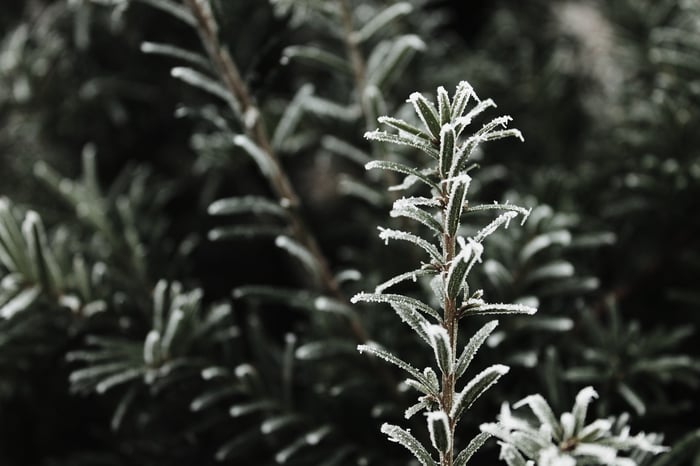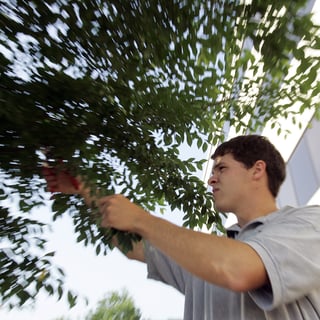Winter damage on plants is common in Kentucky. The damages occur for various reasons and can oftentimes be prevented. Here are some tips for preventing and/or minimizing winter damage to your plants which in turn saves you money by avoiding costly plant replacements.

Right Plant Right Place
Protecting your plants during winter begins long before the first frost—it starts with putting the right plant in the right place. Plants are frequently placed without considering the conditions they must withstand, such as exposure to salt and excessive wind. Boxwoods, for example, are a common hedge. But because they are not salt-tolerant, they can suffer from salt damage and require treatment or even replacement come spring. A good designer will know which plants can withstand salt or drying winter winds. Another common mistake is to install plants not entirely cold hardy for our USDA zone 6 winters. Leyland Cypress and Crape Myrtles are common sights in landscapes, but they are frequently damaged or even killed during a cold winter.
Maintain Trees & Shrubs Properly
 A proper maintenance program can prepare your plants and landscape for winter. Ice storms are fairly common in Central Kentucky during winter, and freezing precipitation can stress trees and shrubs. Proper pruning of trees creates a strong scaffolding of branches better able to withstand winter winds and ice storms. (Check out our comprehensive guide to dormant pruning here.) If a tree is damaged by ice, severe pruning of limbs may be necessary.
A proper maintenance program can prepare your plants and landscape for winter. Ice storms are fairly common in Central Kentucky during winter, and freezing precipitation can stress trees and shrubs. Proper pruning of trees creates a strong scaffolding of branches better able to withstand winter winds and ice storms. (Check out our comprehensive guide to dormant pruning here.) If a tree is damaged by ice, severe pruning of limbs may be necessary.
Avoid late season applications of fertilizer as this creates soft new growth easily damaged by cold weather. Also control pests and diseases throughout the growing season. Winter is a time stress for plants, and if they are already stressed by pests and diseases going into winter they are more likely to be damaged or even die.
Apply Mulch to Beds
Mulch regulates temperature and moisture—and mulch also reduces frost heave, which can force perennials out of the ground and cause them to perish. A thin layer of mulch before winter provides added protection for trees, shrubs and perennials. So, consider applying mulch to landscape beds and tree rings.
Irrigate Plants
Yes, your plants do need water during winter. This time of year, properties’ irrigation systems are off, but plants still require adequate moisture to stay healthy even during dormancy. Plants tend to dry out in winter—and with our fluctuating temperatures in Central Kentucky, we can have a 70-degree day in January, so plants get parched whether they are evergreen or deciduous. Thirsty plants are more susceptible to wind and cold damage. (The proper term for this is desiccation.) Anti-desiccants are available and are frequently used on boxwoods, which tend to suffer from wind damage more than other plants, especially when positioned on rural properties where open land invites more wind and cold.
Pro Tip: Request a water truck for watering newly installed landscapes during warm periods since irrigation systems are winterized.
Consider Wind Breaks and Tree Wraps
Wind breaks can protect plants from gusts and salt spray. Burlap fence between a row of plants and the roadway can mitigate exposure to damaging salt, which is an evitable side effect street-side landscapes deal with in winter. (Tip: We recommend physically spraying off plants and turf with water after snow melts to dilute the build up of deicing agents. This small effort can go a long way toward mitigating salt damage.) Tree wraps can prevent sun scald on tree trunks with thin bark, such as Maples. We often spot sun scald on the southwest sides of trees, and the condition causes irreparable damage to trees.
Warm Weather Warnings
 Usually, winter damage is associated with cold weather and windy conditions, but the truth is, warm winters are also problematic. Diseases tend to manifest during warmer winters, and soils can get waterlogged, leading to issues such as root rot and low-oxygen. Fluctuating temperatures can prompt some plants to break out of dormancy. The plants begin growing and suffer once temperatures drop again. Several early blooming plants, like Saucer Magnolias, often have their flowers zapped by freezing temperatures.
Usually, winter damage is associated with cold weather and windy conditions, but the truth is, warm winters are also problematic. Diseases tend to manifest during warmer winters, and soils can get waterlogged, leading to issues such as root rot and low-oxygen. Fluctuating temperatures can prompt some plants to break out of dormancy. The plants begin growing and suffer once temperatures drop again. Several early blooming plants, like Saucer Magnolias, often have their flowers zapped by freezing temperatures.
Prepare Plants for Winter—And Beyond
By taking these simple steps to prepare plants for winter, you can mitigate damage from cold and wind. But keep in mind, these best practices should be continued through spring. And should damage occur, it’s important to promptly remove damaged limbs to prevent further decline in health.
Let’s talk more about preparing your property for winter by getting your landscape ready for the cold season and lining up snow and ice removal service. Call us any time in Lexington at 859-254-0762 and Louisville at 502-264-0127. Or, fill out this simple form to request a proposal.


